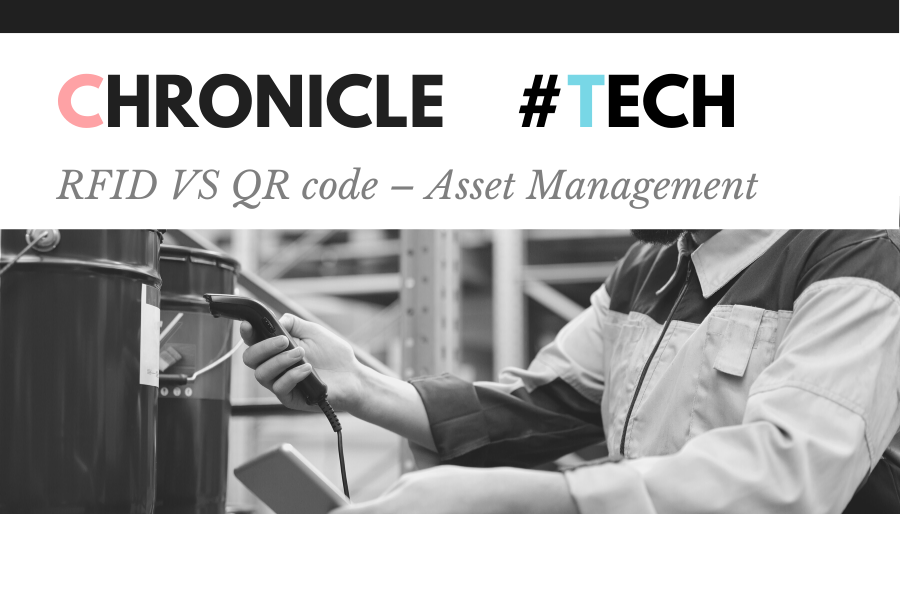QR tags or RFID tags? Which data management system is right for your business? Read on to find out more.

The Wrangle
What is the difference between QR code asset tags and RFID asset tags? Both of them share a similar purpose and usage – for asset management and tracking – that is to update and track an asset’s info (such as location) and record by scanning the unique tag that differentiates each asset.
While RFID tags have higher functionality and connectivity (e.g. scannable in bulk remotely), QR tags are often a lot cheaper and more practical as they’re easier to generate.
There is a lot to consider before you decide on which to invest into – You never wanted to spend a lot on an RFID system and then use it in the same way you’d be using QR tags.
QR code Technology
Quick Response Code (QR code) is a machine-readable 2D matrix code consisting of an array of black and white squares, typically used for storing URLs or other information for reading. It can be scanned using a QR scanner but more commonly by digital devices nowadays (smartphones, tablets with built-in camera).
QR Benefits
QR tags have two main benefits. The first is it is much cheaper. They can be generated easily by simply printing out the codes on paper. This means you don’t have to worry about the lead time when placing an order on QR tags as they should be delivered quickly (at fast within 7 days since order placed) compared to RFID tags.
The second benefit is QR tags are easy to configure – all you need is a smartphone and some software for asset maintenance to make the whole system work.
QR Drawbacks
QR tags have two main drawbacks. The first is its lack of applications compared to RFID tags due to limitations such as you can only scan one QR code at a time, manually. A line of sight and a visual light environment are required to scan the code.
The second drawback is there is a higher chance of associated human errors, as each QR tag on each asset needed to be scanned manually. In case a QR code asset tag is not spotted and thus isn’t scanned, an asset may potentially remain unaccounted for, and extra time is wasted on tracking the unattended asset.
RFID Technology
Radio-frequency identification (RFID) uses electromagnetic fields to automatically identify and track tags attached to objects.
Types of RFID Tag
There are two main types of RFID tag currently in the market – Passive RFID tag and Active RFID tag. They serve different purposes and different applications.
Passive
Passive tags do not require any internal power source or battery as there are “powered” by the electromagnetic energy sent from an RFID reader. This means passive RFID tags can be shaped smaller in size, and are more durable, allowing the feasibility to use them in harsh conditions. For the scanning range – although it is a lot broader than a QR code (range of at most 10m) – it is still a lot restricted than with an active RFID tag.
Active
Active tags do require an internal power source which means that they must size larger than passive tags – which affects their longevity and durability. For the scanning range – active tags can be read from a much larger distance than passive tags (range of up to 100m!). However, they have to be replaced sooner than a passive tag, once the battery fails.
RFID Benefits
The first benefit is time efficiency. As RFID tags have a much larger scanning range than QR codes, you can scan multiple tags at the same time – instead of scanning assets one by one. RFID tags also have more applications than QR tags (QR codes must always be “read-only”, whereas RFID tags can be “read-write”) – they enable a reading/writing ability which means assets can be changed and updated and communicated with whilst they’re either in use or in transit. For asset management, this means updating an asset register is a lot faster and simpler, as communication with assets can be more remote and done with a lot more ease.
RFID Drawbacks
The main drawback of using RFID is the price. The price of RFID tags can vary a wide range, depends on your need for the functionality of the tags (low/high read range, low/high durability etc). RFID Scanners are expensive as they are special scanners with near field communication (NFC) capabilities.
RFID tags also have a constraint – they can be unreliable if used close to a magnet, liquid, or certain types of metal, therefore they won’t be a great pick for all types of products. Also, as they have microchips in them, they’re vulnerable to hacking from unethical parties who want to steal your product information.
Decision?
It’s all about your specific purpose.
The benefit of RFID tags is that you can scan a bulk of assets at once – from any direction, even from a distance, and even when the tag is obscured by a wall or box. QR tags can serve the same purpose – it’ll just be a little slower and cheaper.
The answer, therefore, is to think about if what you’re doing can be done with QR tags. If it can’t, think about if it can be done with passive RFID tags. If it can’t, think about if it can be done with active RFID tags. Whether you want to make this investment depends on your company’s or individual needs.
QR tags best for:
Semi-automated inventory management
RDIF tags best for:
Automated inventory management
Unless your assets need to be scanned from a wider distance, in bulk, or with no line of sight, it might be better to invest in QR tags.
After all, it depends on your purpose and your budget.
Reference
1.https://itemit.com/qr-vs-rfid-which-is-better/
2.https://www.business.org/finance/inventory-management/rfid-vs-barcodes-vs-qr-codes/#QR

